Arts & Culture
50 Reasons We Love the South Now
Some may call it bragging. We call it counting our blessings
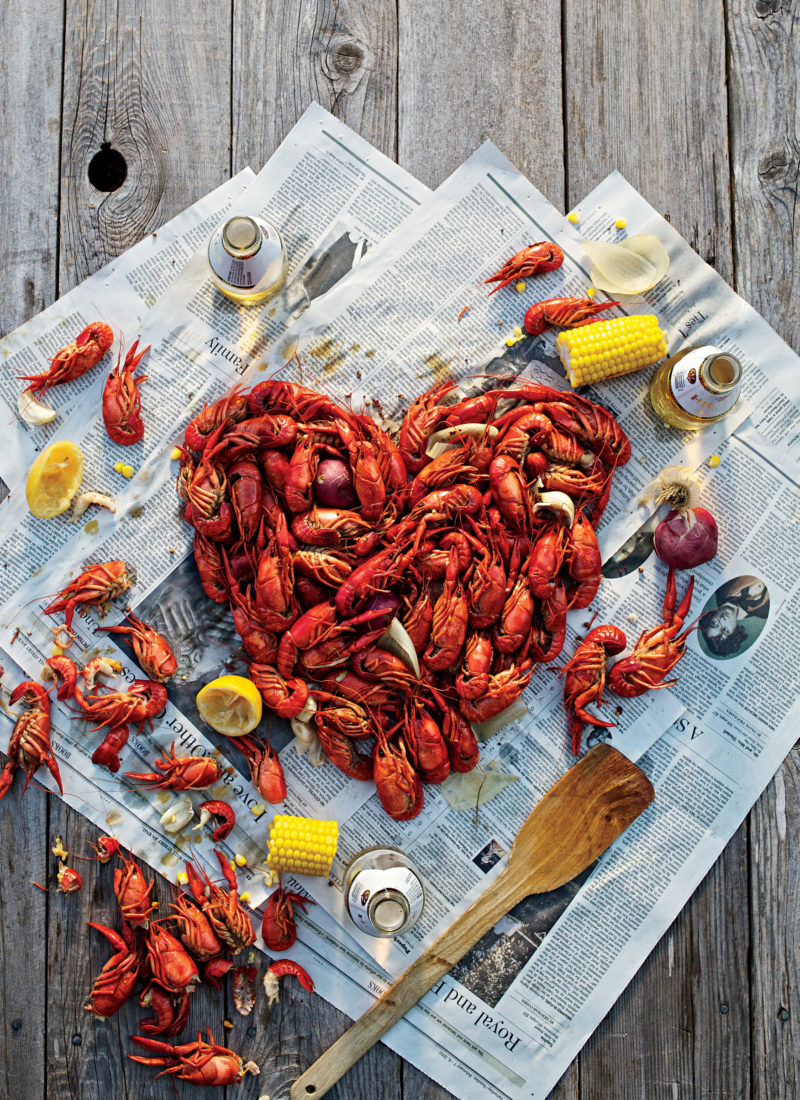
Photo: Jody Horton
Our region’s charms are well documented, but there’s something to be said for taking stock of the people, places, and things that make us proud.
Nº 01
THE SCENT OF THE MAGNOLIA
A love letter to the fragrant South by Frances Mayes
>Read the essay
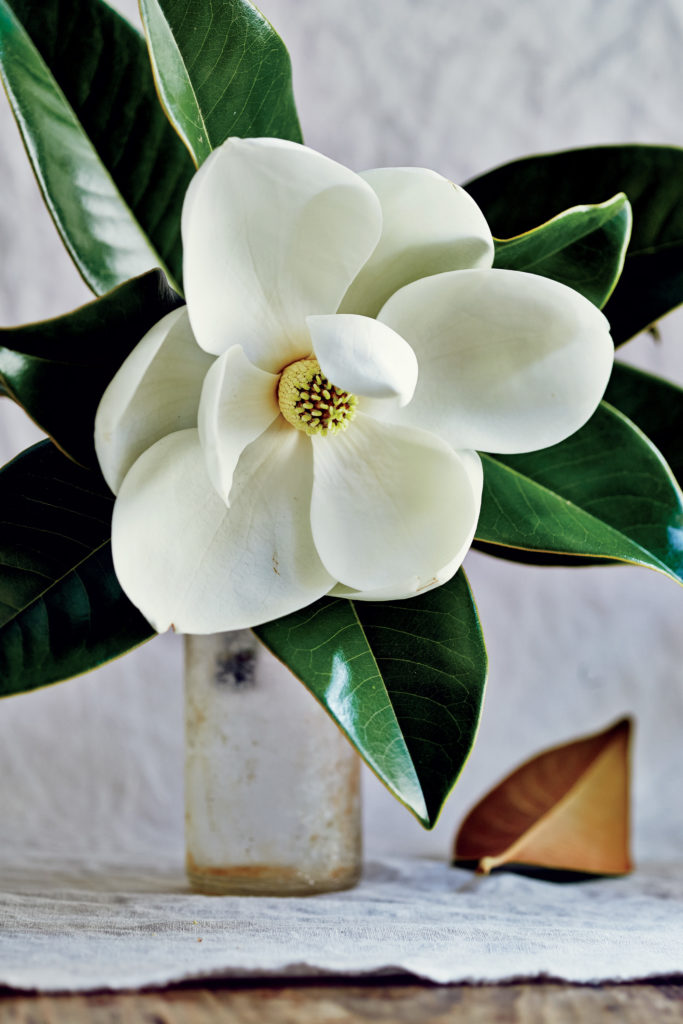
Photo: Peter Frank Edwards
A magnolia blossom.
Nº 02
ODETTE FEEDS FLORENCE
“I’m not venturing very far on this one—what I love most about the South right now is literally next door to our studio here in Florence, Alabama: Odette. What a treat to have them here, with a great, ever-changing menu and incredible specials, not to mention more special bourbons than any bar in the state. I ate there four times in a week!”—Billy Reid, clothing designer
Nº 03
OUR CHEFS ARE MORE THAN JUST CHEFS
As chefs have become bona fide cultural celebrities, their influence has expanded beyond the confines of the kitchen; what they say and do matters as much as what they cook. Fortunately, many Southern chefs have proved up to the challenge of public life, staying grounded even as they embrace the positive power of the spotlight. There’s no better example than John Currence, the man who turned Oxford, Mississippi, into a dining destination. In addition to speaking out against discrimination and raising money for the University of Mississippi’s children’s hospital, Currence, who eschews the term activist, was recently appointed to the board of the Human Rights Campaign. “As chefs, we have a responsibility to do more than just make delicious food,” he says. “We can be a part of creating something better than all of us.” chefjohncurrence.com
Nº 04
HENRI MATISSE’S GREAT-GRANDSON IS A PROUD NORTH CAROLINA POTTER
Sure, the Tar Heel potter Alex Matisse has a famous last name, but the younger artist’s ability to render lumps of North Carolina clay into gallery-worthy pitchers, plates, and vases speaks for itself. Although a native New Englander, Matisse opened East Fork pottery in Marshall in 2010 and considers Appalachia his creative home. “There is this world of pottery, a little clan, that exists here more so than anywhere else in the United States,” he says. Mark your calendar for the spring kiln sale on May 16, and look for a new retail space to open in Asheville later this year. eastforkpottery.com
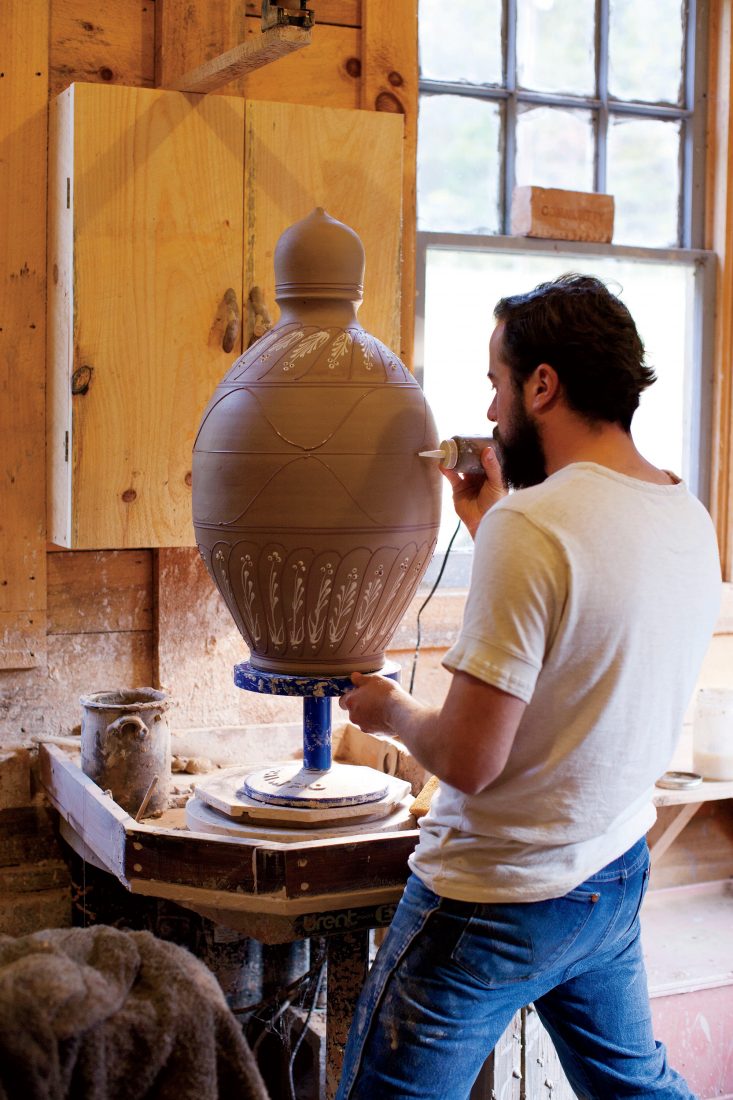
Photo: Whitney Ott
Potter Alex Matisse in his North Carolina studio.
Nº 05
WE’RE BRINGING QUAIL BACK
It hasn’t been easy. After the region’s wild quail population began to nosedive several decades ago, some experts surmised that the future of quail hunting might strictly involve pen-raised birds. Not if the researchers at Tall Timbers, in Tallahassee, Florida, have anything to say about it. Their plan to restore flocks of wild quail to the Southern landscape calls for the reconstruction of sweeping expanses of native trees and grasses, and a carefully considered breeding program that engineers hardy birds with wild genetics. For the chance to see these birds flush once again, it’s worth the trouble. talltimbers.org
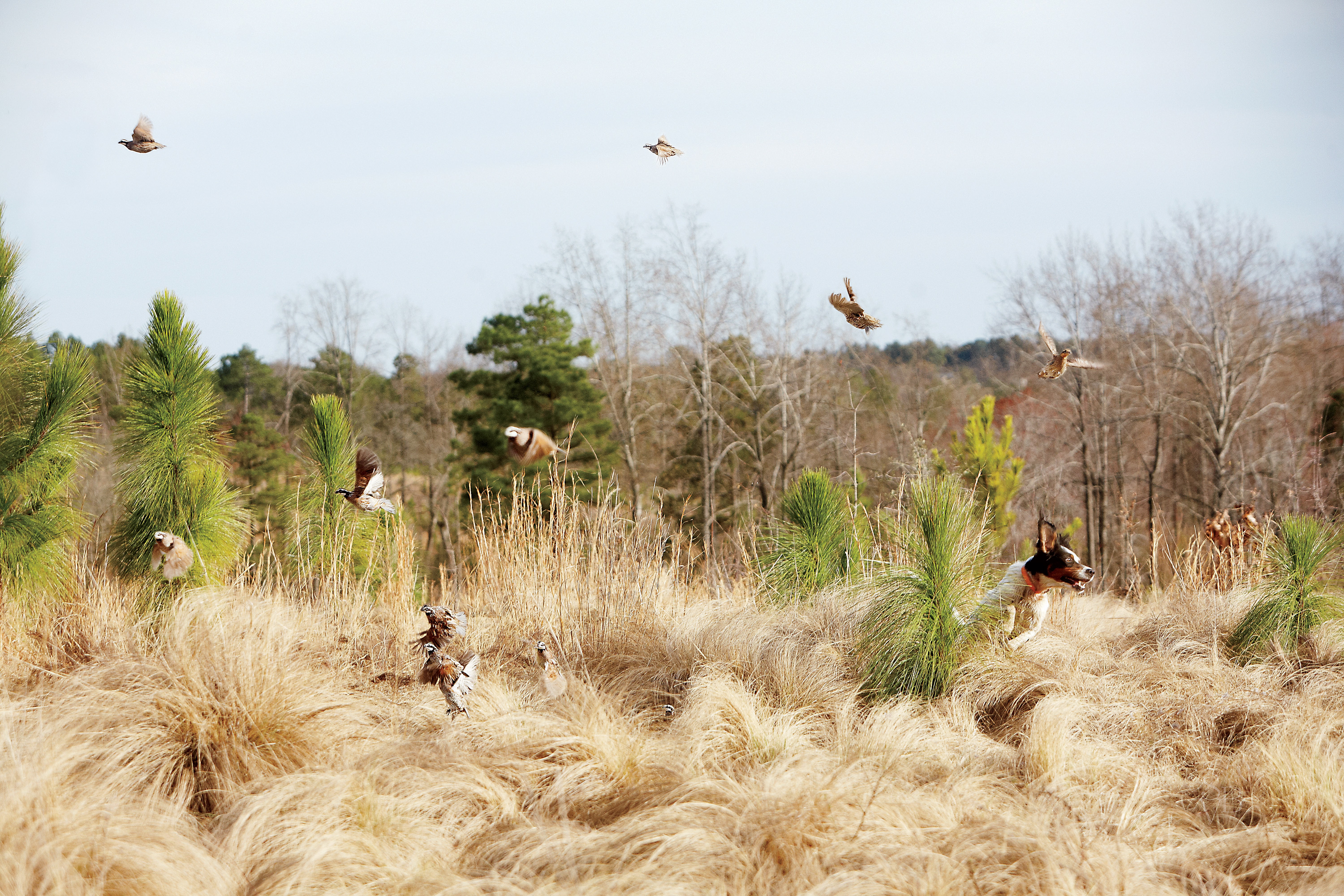
Photo: Stacey Van Berkel
Survival Stories
Tallahassee, Florida's Tall Timbers is working to restore the South's wild quail populations.
Nº 06
WE EMBRACE THE PAST
“My favorite thing about the South is that it never turns its back on its mistakes. Our history has some seriously rough edges but we don’t file them down or sand them smooth. We live with them and move on. And that flavors every single aspect of Southern life. What else do I love right now? Carolina rice and coconut vinegar.”—Alton Brown, Georgia-based author and Food Network star
Nº 07
HOSPITALITY IS SERIOUS BUSINESS
Frank Stitt’s stellar cuisine isn’t the only thing that keeps people coming back to Birmingham, Alabama’s Highlands Bar and Grill. Since the beginning, they’ve also been charmed by Goren Avery, better known as Red Dog, the front-of-house “ambassador” who works the dining room and has been a standard-bearer for service for more than thirty years. At the Southern Foodways Alliance’s annual symposium last October, Avery’s peers, including John T. Edge and the filmmaker Joe York, paid tribute to that illustrious career with the Ruth Fertel Keeper of the Flame Award, presented annually to “an unsung hero or heroine” of Southern food. “He’s like the Bobby Fischer of waiters,” York says. “He’s always working six or seven moves ahead.” highlandsbarandgrill.com
Nº 08
KING BISCUIT TIME STILL ROCKS THE RADIO
Sonny “Sunshine” Payne first heard the blues as a young boy in Helena, Arkansas—in churches, in fields, and on farms, but never on the radio. That changed in 1941, when a sixteen-year-old Payne introduced his friend Robert Lockwood, Jr.—and blues partner Sonny Boy Williamson—to the station manager at KFFA radio, where Payne worked as an errand boy. The King Biscuit Time radio show was born, and the Delta blues had a home. Today, the show is the longest-running radio program in history, and ninety-year-old Sonny is still its announcer, broadcasting Monday through Friday for thirty minutes at 12:15 p.m. (CST) and playing the music he helped the world discover. kffa.com
Nº 09
LIVERMUSH!
Cook a pig’s liver until it’s just tender. Grind it into a paste, and then mix that with salt, black pepper, sage, and cornmeal. Form the batter into a sliceable brick, and you have livermush. Shaved and fried in butter, it’s an old-fashioned breakfast treat with plenty of fans in and around Shelby, North Carolina, home to the annual Livermush Festival. To see what the fuss is all about, book your ticket to the October 2015 showcase. You just might run into Clark Barlowe of Charlotte’s Heirloom restaurant, Craig Deihl of Charleston, South Carolina’s Artisan Meat Share, or any of the other Southern chefs who pay tribute to the long-standing dish on their menus.
Nº 10
PAT CONROY IS NOW AN EDITOR
Pat Conroy may have closed the book, so to speak, on his father with The Death of Santini in 2013, but he opened the door for writers in his adopted home state, South Carolina. The mission of his budding imprint, Story River Books, a division of the University of South Carolina Press, is to publish “high-quality fiction with South Carolina ties,” according to Conroy, who, in his role as editor-at-large, plans to shepherd nine new titles to print in 2015 alone. storyriverbooks.com
Nº 11
150 YEARS LATER, STETSON HATS ARE AS STYLISH AS EVER
No one wears a Stetson by accident—because, say, it was the first thing he spotted in the closet that morning. Long after the hat’s invention in 1865, a Stetson still signifies something—some version of I can get it done, whatever it happens to be: ride a bull, sell you a Cadillac, or send you away from the card table dejected (as with the poker legend Amarillo Slim, whose trademark ten-gallon shaded his eyes from opponents’ scrutiny). Back in 1928, Louis Armstrong and His Savoy Ballroom Five, in the mournful blues classic “St. James Infirmary,” enshrined the lid with an indelible status:
When I die, I want you to dress me
in straight-laced shoes
Box-back coat and a Stetson hat
Put a twenty-dollar gold piece on
my watch chain,
So the boys will know that I died
standin’ pat.
Even when you depart, a Stetson tells the world you’ve arrived. stetson.com

Photo: Tyler Sharp
Stetson's Open Road hat, worn by LBJ and others.
Nº 12
THE GUITAR PULL
Making music the old-fashioned way—on the porch by Robert Hicks
>Read the essay
Nº 13
TENNESSEE’S ANSWER TO MOUNTAIN DEW
Feeling achy? Nursing a nasty hangover? Suffering from indigestion, headaches, or heartburn? Try a swig of Dr. Enuf. Since 1949, folks in eastern Tennessee have sworn by the healing powers of the regional soda, a crisp lemon-lime tonic fortified with vitamins and minerals (plus plenty of caffeine and sugar). We can’t vouch for its medicinal properties, but it can surely give you an afternoon jolt. drenuf.com
Nº 14
THE CIRCLE BURGER SIZZLES ON
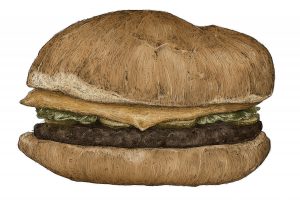 Half a century ago, you could have grabbed a to-go sack of Blue Circle sliders at any one of some thirty locations across Appalachia and the Mid-South. But in the wake of corporate turmoil in the sixties and seventies, only one franchise held its ground. A rusty, doughnut-shaped sign alongside the Bluff City Highway in Bristol, Tennessee, marks a steamy time capsule where hundreds of Circle Burgers, square two-and-a-half-inch griddled patties topped with mustard, hot onions, and a pickle, still come off the flattop daily. Eat twenty-six of them in half an hour, beating the current record, and you can walk away without paying a dime. bluecircleburger.com
Half a century ago, you could have grabbed a to-go sack of Blue Circle sliders at any one of some thirty locations across Appalachia and the Mid-South. But in the wake of corporate turmoil in the sixties and seventies, only one franchise held its ground. A rusty, doughnut-shaped sign alongside the Bluff City Highway in Bristol, Tennessee, marks a steamy time capsule where hundreds of Circle Burgers, square two-and-a-half-inch griddled patties topped with mustard, hot onions, and a pickle, still come off the flattop daily. Eat twenty-six of them in half an hour, beating the current record, and you can walk away without paying a dime. bluecircleburger.com
Nº 15
WE ALWAYS HAVE A JOKE READY
From Aziz Ansari to Zach Galifianakis, the South has birthed some of today’s most serious comedic talent. Arkansas native Clark Duke is no exception. Having garnered laughs from TV audiences as Clark Green on The Office, the up-and-coming funnyman says he comes by his joke-telling prowess honestly. “I’m not sure this is the first joke I ever heard,” he says, “but it’s the first one I recall really sticking with me. Courtesy of my mother:
You know how to catch a unique rabbit?
You neek up on him.
You know how to catch a tame rabbit?
Tame way, you neek up on him.
Good night everybody!”
Nº 16
THERE’S A MARDI GRAS KREWE DEDICATED TO DR. SEUSS
In a town filled with over-the-top sights in the weeks leading up to Mardi Gras, New Orleans’ Krewe de Seuss might just take the king cake. For the past three years, legions of furry-wigged Things have tricycled behind a float decked out like a fantastical horned instrument. By way of explanation, founding member (and occasional G&G contributor) David Thier says, “It becomes nearly impossible to describe actions that seem perfectly reasonable and normal in New Orleans—without realizing you are describing the behavior of completely insane people.” krewedeseuss.com
Nº 17
CLAY RICE’S SCISSORS
Clay Rice cut his first silhouette at age six. Tutored in the centuries-old art by his grandfather Carew Rice, arguably the South’s most famous silhouette artist (the poet Carl Sandburg was a fan), he is now, at fifty-six, closing in on his millionth paper cutout. Thousands of parents from Mississippi to Maryland commission profiles of their children each year. “Southerners have such a strong sense of family, and place,” Rice says of his craft’s enduring popularity. But beyond portraits, his deft scissors also render starkly beautiful scenes of the South Carolina Lowcountry, where he grew up, and fill the pages of his award-winning children’s books, the newest of which hits shelves this September. clayrice.com
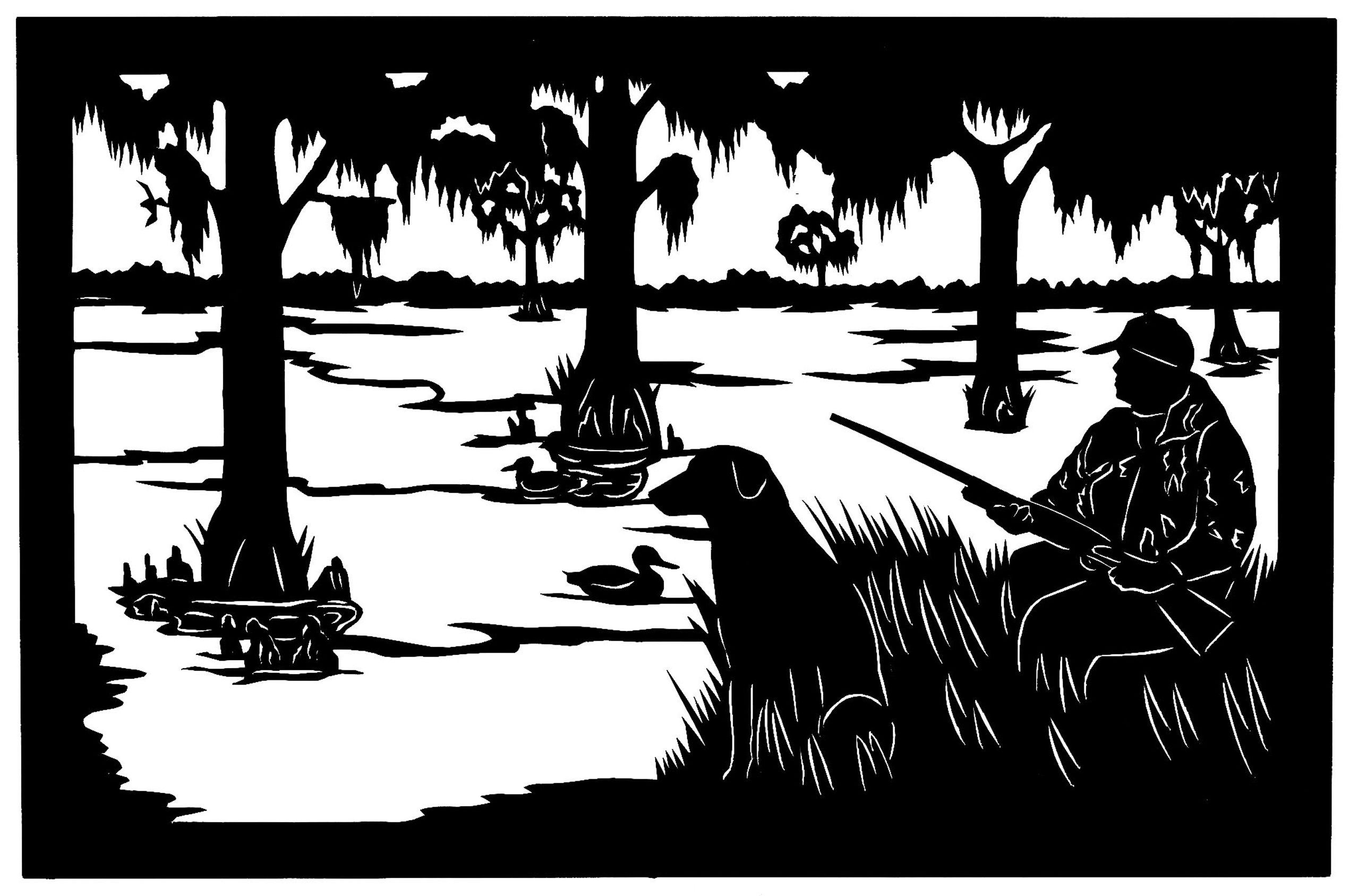
Illustration: Courtesy of Clay Rice
A Lowcountry hunt scene from the artist Clay Rice.
Nº 18
OUR PEOPLE ARE OUR EMBASSADORS
“Sure, I like the architecture, gardens, food, beaches, and blues. But the people are our ambassadors. When you meet ‘the South’ in the form of a person, you meet a storytelling, belly-laughing, back-slapping, authentic soul. Southerners are spontaneous and hospitable; they can throw a party on short notice, and yes, bring the houseguests. To distill it, it’s the confidence and ease, humor and hospitality…hell, I hope they put that on my tombstone.”—Charlotte Moss, Virginia-raised interior designer
Nº 19
HOUSTON’S ASIAN FOOD BOOM
 Census data show that Houston has one of the country’s largest and fastest-growing Asian populations, a statistic that translates into destination-worthy dishes with authentic flavor: stunning steamed shrimp dumplings from HK Dim Sum; pork buns from Fu Fu Café; black bean ramen from Soma; Viet-Cajun fare from Crawfish and Noodles. The newest stars of this blossoming scene are Cory Xiong and Heng Chen of Mala Sichuan, which gets its tingly peppers from China and wine list from respected local sommelier Justin Vann.
Census data show that Houston has one of the country’s largest and fastest-growing Asian populations, a statistic that translates into destination-worthy dishes with authentic flavor: stunning steamed shrimp dumplings from HK Dim Sum; pork buns from Fu Fu Café; black bean ramen from Soma; Viet-Cajun fare from Crawfish and Noodles. The newest stars of this blossoming scene are Cory Xiong and Heng Chen of Mala Sichuan, which gets its tingly peppers from China and wine list from respected local sommelier Justin Vann.
Nº 20
COLLINGS GUITARS
If you’ve ever enjoyed the sounds of Lyle Lovett, Joni Mitchell, or Zac Brown, then you’re also a fan of Bill Collings, the man whose guitars power their music. Though he and his team now work in a 27,000-square-foot space in Austin, Texas, Collings’s instruments still sound like they did when he started making them alone on his kitchen table in 1973. Each of his pieces—acoustic, electric, and archtop guitars, plus mandolins and ukuleles—is carefully shaped by hand with a rigorous attention to detail. Though that type of craftsmanship may be fading, luckily for music lovers, Collings Guitars are not. collingsguitars.com
Nº 21
GOLF’S GREATEST CADDIE IS AT PINEHURST
“Show up. Keep up. Shut up.” That’s the philosophy Willie Lee McRae adopted when he first caddied, in 1943. Seventy-two years later, he’s Pinehurst No. 2’s most distinguished looper. He’s caddied for the greats (Bobby Jones and Sam Snead) and the celebrities (Michael Jordan, Bo Jackson), but also the seven- and twelve-year-old brothers from Connecticut who broke 100 without lessons, and the lawyer from Kentucky who wrote a letter thanking him for fixing the ever-hooking swing no one else could. “Makes you feel good when you can help somebody,” McRae says. That’s why he still caddies at the famed North Carolina course, where one of his sons and a grandson now work, too. Well, that and maybe one other reason: “Ain’t nobody know the golf course better than me.” pinehurst.com
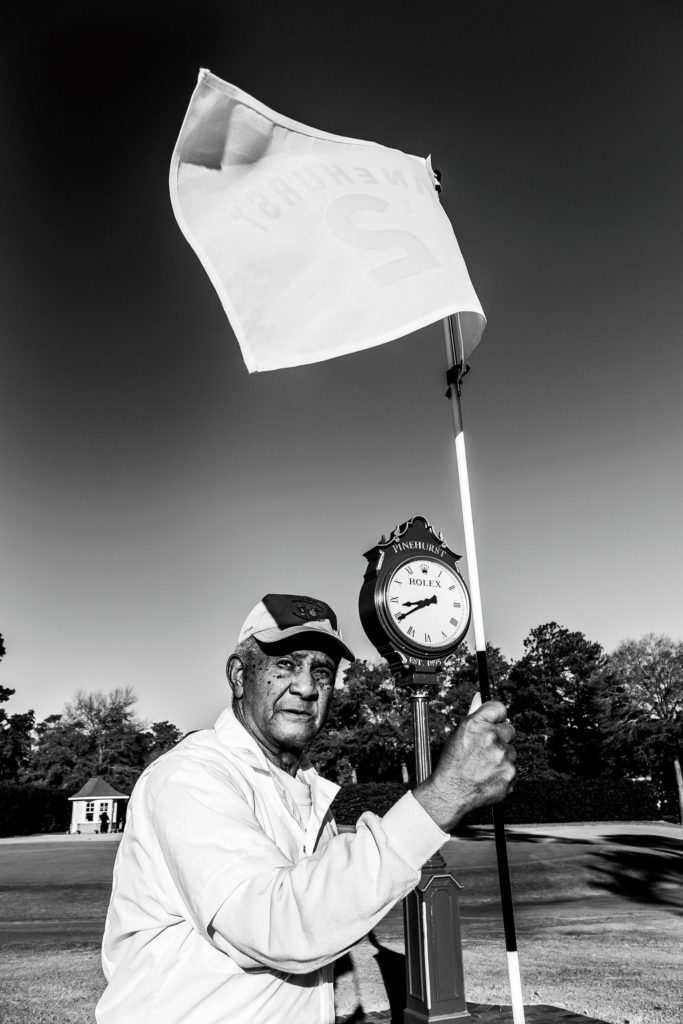
Photo: Gately Williams
Sports Figures
Pinehurst, North Carolina’s famous caddie Willie McRae.
Nº 22
THESE GUYS!
They wear snug powder-blue shorts. They’re big on facial hair. They listen to “Safety Dance” and MC Hammer on purpose. And six years after their start, they’re already a New Orleans institution. They’re the 610 Stompers, an all-male amateur marching dance troupe of more than a hundred “ordinary men” clad in matching white headbands, red satin jackets, knee-high tube socks, and spray-painted gold sneakers. They’ve brought their synchronized (more or less) moves to charity functions, Saints halftimes, and The Tonight Show. The choreography: part open-bar wedding, part hippo ballerinas from Fantasia, part Zumba class gone awry. But just try to watch them and not start dancing along. 610stompers.com

Photo: Rush Jagoe
Louisiana's 610 Stompers storm Baton Rouge.
Nº 23
COWBOYS ROAM THE FLORIDA FRONTIER
Florida: home of gators, theme parks, snowbirds, and…cowboys? Yes, cracker cowboys— so named for the sound their whips make—are still tending descendants of the cattle the Spanish introduced in the 1500s, when they settled the territory. Dr. William Broussard’s Crescent J Ranch in St. Cloud has the world’s largest herd of this diminutive relative of the Texas longhorn. And on similar ranches across Florida, cowboys still roam the land where some of the first ranching started and where, as development encroaches, it might also end.
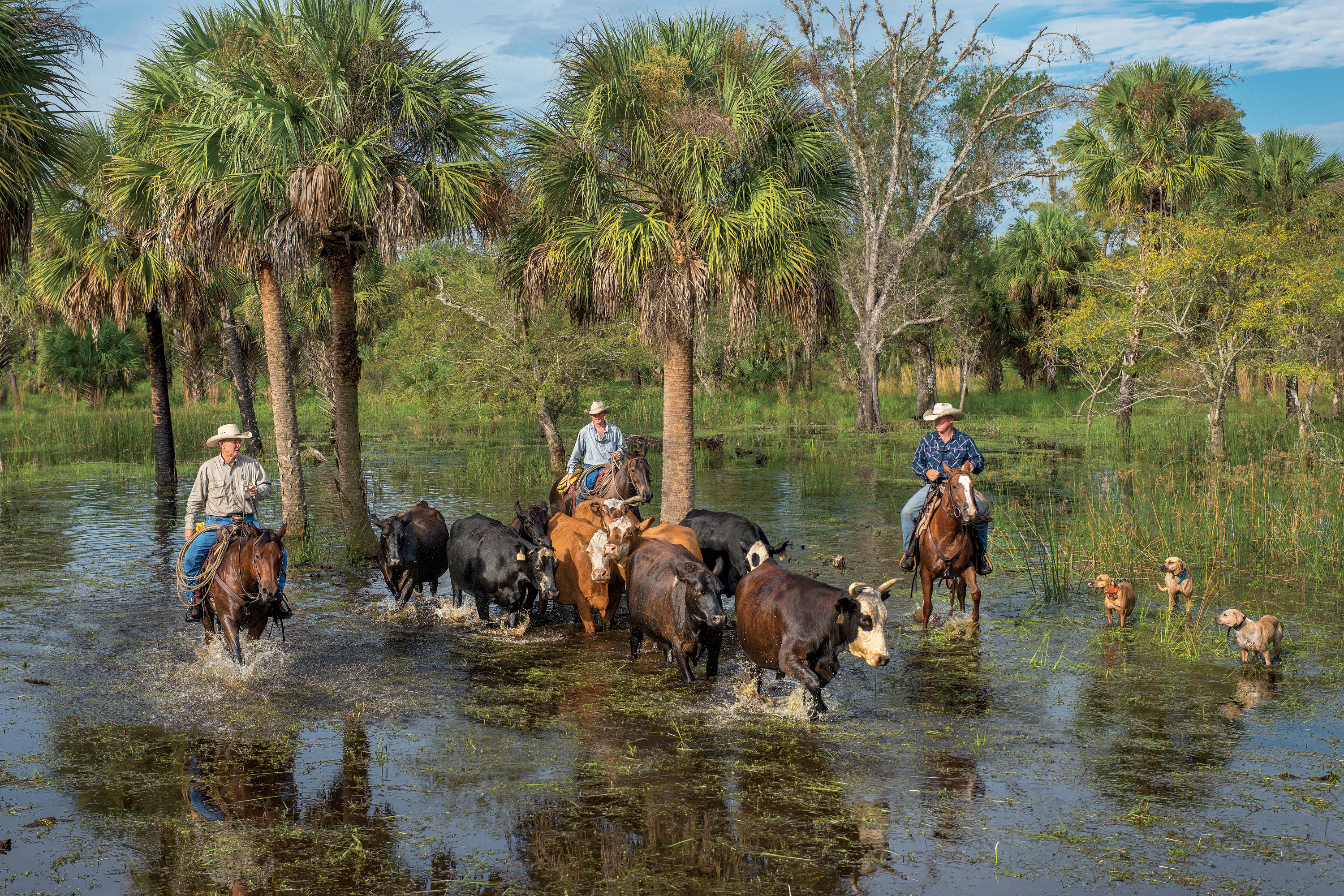
Photo: Carlton Ward Jr.
Hoofing It
Florida cracker cowboys herd cattle.
Nº 24
THE ULTIMATE CHEESE BISCUIT
You may have tried cheese biscuits. But unless you live around Greenville, Grimesland, or Wilson, on the eastern side of I-95, you’re probably not familiar with North Carolina’s uniquely hedonistic variety. Across the area, cooks like those at Abrams restaurant in Tarboro bake fat knuckles of hoop cheddar in crispy casings of buttermilk biscuit dough. The result: golden-brown softballs that crumble on contact to reveal molten, delightfully greasy centers.
Nº 25
D.C.’S SECRET GARDEN TURNS SEVENTY-FIVE
Despite being the only woman among the American Society of Landscape Architects’ founders, Beatrix Farrand preferred the more modest term landscape gardener. The title sums up the naturalistic approach she took when creating her Washington, D.C., masterpiece, Dumbarton Oaks, which opened to the public in 1940. Tucked away in Georgetown, the twenty-seven-acre garden is often overlooked amid the capital’s many landmarks and monuments, but its low profile is also part of the enchantment. Walkways and stairways snake through stands of weeping cherry trees and past blooming collections of dogwoods, wisteria, and Virginia bluebells. And the entrance? You’ll find it, fittingly, off of R Street down Lovers’ Lane. doaks.org
Nº 26
THE GREAT WALL OF ALABAMA
On his wooded land just east of milepost 338 on the Natchez Trace Parkway near Florence, Tom Hendrix, after retiring from the nearby Ford plant, spent some twenty-five years assembling the Wichahpi Commemorative Stone Wall. Higher than six feet in some spots, it winds for more than a mile. Hendrix built the monument—stacking more than eight million pounds of stones one by one, by hand, without mortar—in tribute to his great-great-grandmother, a Yuchi Indian named Te-lah-nay, who as a teenager in 1839 began a nearly five-year-long walk back to her home from Oklahoma, where she’d been forced to relocate along the Trail of Tears. Now eighty-one, Hendrix welcomes visitors from all over the world. “An incredible journey,” he calls Te-lah-nay’s odyssey. You could say the same about his wall.
Nº 27
COCHON DE LAIT
 Across Cajun country, it’s not a party without cochon de lait, a delicacy that gets its own festival in Mansura, Louisiana, during the second weekend in May. Since 1961—minus a fifteen-year hiatus following an especially rowdy occasion fueled by fruit-flavored wine—volunteers have annually pressed a dozen or so splayed-out suckling pigs into wire cages, cooked the seasoned meat slowly over a wood fire, and paired the roast pork with delicious dirty rice. It’s whole hog, Cajun-style. cochondelaitfestival.com
Across Cajun country, it’s not a party without cochon de lait, a delicacy that gets its own festival in Mansura, Louisiana, during the second weekend in May. Since 1961—minus a fifteen-year hiatus following an especially rowdy occasion fueled by fruit-flavored wine—volunteers have annually pressed a dozen or so splayed-out suckling pigs into wire cages, cooked the seasoned meat slowly over a wood fire, and paired the roast pork with delicious dirty rice. It’s whole hog, Cajun-style. cochondelaitfestival.com
Nº 28
HUNTING AND FISHING ARE ART FORMS
“The South smells of red cedar and red dirt…She tastes of Gulf shrimp and coarse-ground grits. She sounds like shot shells at a Saturday dove shoot and is seen through live oak boughs draped with Spanish moss. The South moves slowly enough to be known.”—Flip Pallot, Florida fly fisherman TV host
Nº 29
QUILTING’S RENAISSANCE WOMAN
Thirty-three-year-old Maura Ambrose is proof that quilting isn’t a dying art. The graduate of Savannah College of Art and Design, and founder of Folk Fibers, hand quilts her functional masterpieces largely out of organic fabrics that she’s dyed in stainless-steel pots on her back porch in Bastrop, Texas, outside Austin. Ambrose grows or forages for the sources of her stunningly vibrant colors: pomegranate, indigo, madder root, lichen, pecans, and Indian paintbrush, to name a few. Then she ships her finished quilts to buyers in a handmade cedar box with a handwritten swatch card identifying those sources. Among her admirers: John Mayer, whose 2014 release “XO” featured cover art with some of Ambrose’s hand-stitched work. folkfibers.com

Photo: Wynn Myers
Maura Ambrose with her modern quilts.
Nº 30
THE MOST COLORFUL ROSES GROW HERE
 Technically, Confederate roses are members of the hibiscus genus, but this incongruously named cool girl of the Southern garden flaunts peony-like blooms that can change from snow white to hot pink in a single day. Regional folklore has it, the rose’s once- white flowers soaked up the blood of dying Confederate soldiers, accounting for the color change. Though they’re hardy and easy to grow, you aren’t likely to find the heirloom blooms at your local garden center. Order a pot from the green thumbs at Woodlanders in Aiken, South Carolina, and plant them now in a sunny spot for early-autumn blooms. woodlanders.net
Technically, Confederate roses are members of the hibiscus genus, but this incongruously named cool girl of the Southern garden flaunts peony-like blooms that can change from snow white to hot pink in a single day. Regional folklore has it, the rose’s once- white flowers soaked up the blood of dying Confederate soldiers, accounting for the color change. Though they’re hardy and easy to grow, you aren’t likely to find the heirloom blooms at your local garden center. Order a pot from the green thumbs at Woodlanders in Aiken, South Carolina, and plant them now in a sunny spot for early-autumn blooms. woodlanders.net
Nº 31
FARMERS’ MARKETS ARE GOING HIGH TECH
Sea Islands Local Outlet (also known as SILO), based in Beaufort, South Carolina, and gradually expanding up the coast, is a pioneer in a growing movement to take farmers’ markets beyond the town square and into the digital space. On its website, shoppers order from a diverse menu of local and regional goods that might include grits, craft beer, fresh breads, and seasonal vegetables. If outfits like SILO continue to crop up, someday we may all be able to sleep in on Saturday morning and buy our milk from the dairy farmer down the road. silo-beaufort.com
Nº 32
WICKER IS GETTING A MAKEOVER
Wicker has been a fixture on the porch for centuries, but Palm Beach interior designer Celerie Kemble is bringing a bit of indoor polish to the outdoor staple. “Wicker furniture provides the perfect meeting point of casual and elegant,” Kemble says. “It has an old-world grace without any stuffy formality.” Her 2015 outdoor collection for Lane Venture includes everything from full dining sets to a fanciful sideboard just right for alfresco summer cocktails. laneventure.com
Nº 33
WE PRESERVE MORE THAN JUST HOUSES
From Maryland to Georgia, tobacco barns are woven through centuries of Southern history. (John Wilkes Booth spent his last hours trapped in one near Bowling Green, Virginia.) Now, a preservation movement is growing to salvage these barns, often built of hand-hewn logs, from the ravages of time, neglect, and development. One laudable effort is Preservation Virginia’s Tobacco Barn Preservation Project, which records priceless oral histories from farmers and doles out small grants to preserve and repair the barns—thousands of which remain standing in Southside Virginia and North Carolina alone. preservationvirginia.org
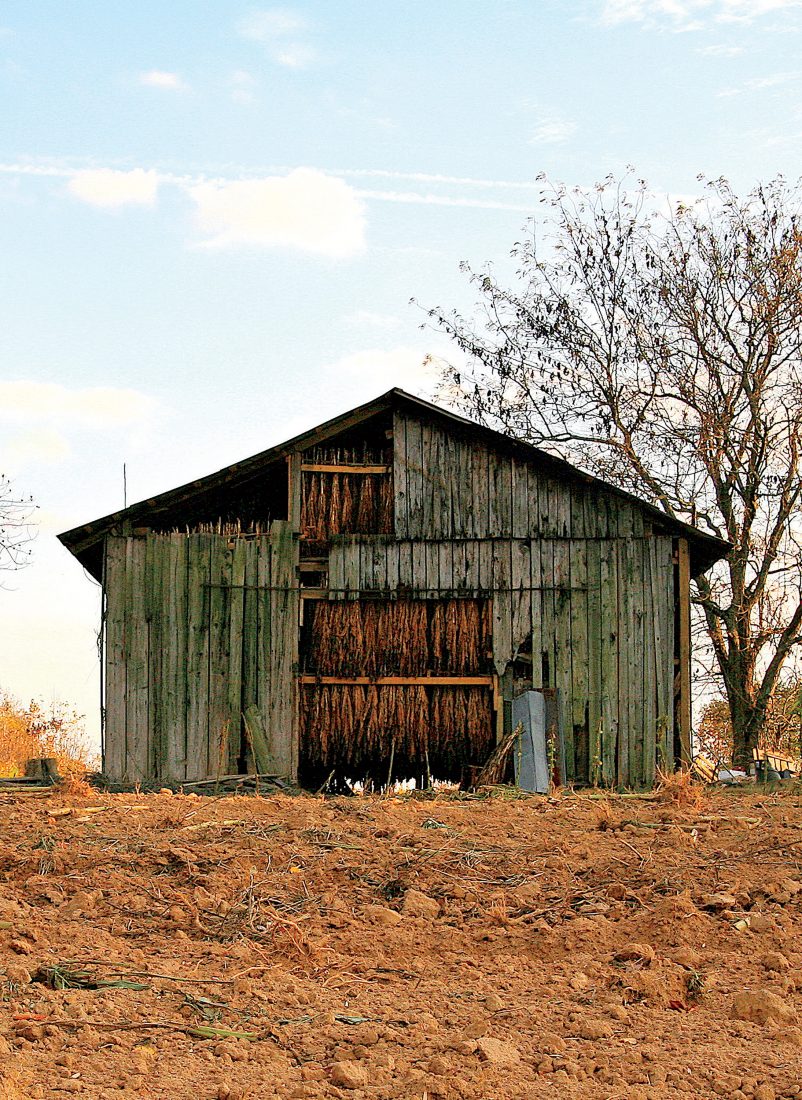
Photo: Jay Sinclair
Hanging On
A salvaged tobacco barn near Walnut Cove, North Carolina.
Nº 34
THE ORIGINAL ROADIE
Ben Holiday “Lovey” Dorcy III worked as John Wayne’s gardener and as a delivery boy for Nudie Cohn, designer of outlandish embroidered suits for country music stars. His defining gig, though, began when he met an up-and-coming musician named Willie Nelson in the early fifties and became by many accounts the world’s first professional roadie. Going on ninety years old, Dorcy has been touring with Nelson and others for around half a century—and he doesn’t plan to hang up his hat anytime soon.
Nº 35
MEXICAN PASTRY SHOPS
Panaderias, the mostly Mexican, family-run bake shops, are small and no-frills—lunch trays, a pair of tongs, and a cafeteria-style line. But the tastes are big. Sprinkled throughout the South, they produce the most delicious traditional Hispanic baked goods imaginable, thanks to bakers like those at Nashville’s El Nuevo Dia, who prepare a daily selection of guava-filled pastries, rich molasses cookies, and cheese-stuffed pan dulce.
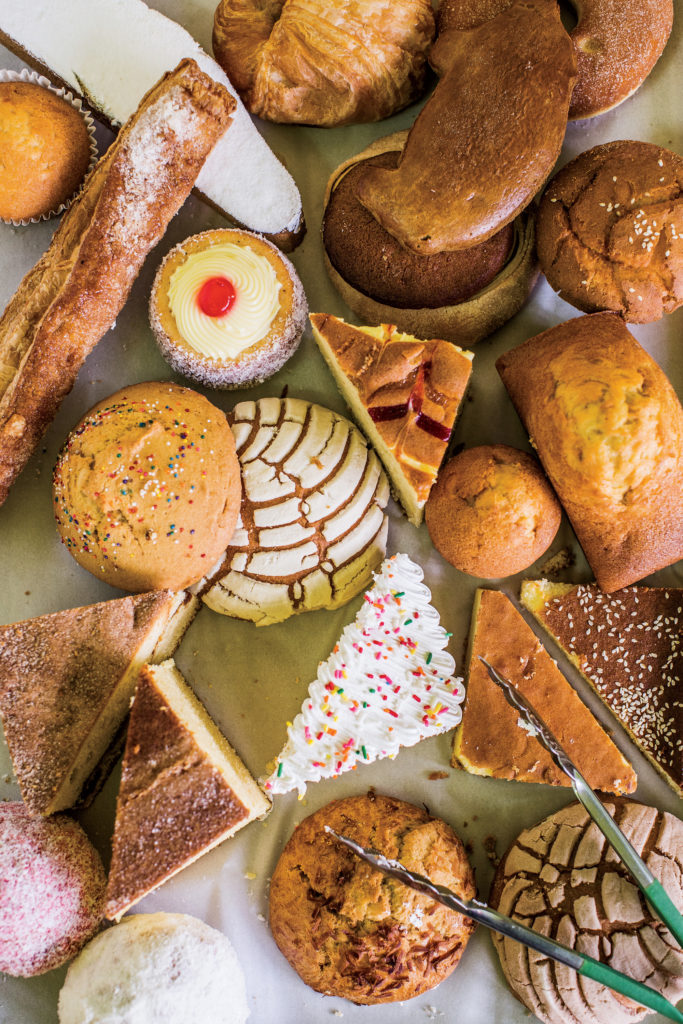
Photo: Andrea Behrends
South-of-the-Border Breads
A sweet sampling from the Nashville panaderia El Nuevo Dia.
Nº 36
HEIRLOOM CAST NETS
On Saturdays, if you’re lucky, you’ll find Charles Williams sitting under a live oak alongside the sweetgrass basket makers who line U.S. Route 17 near McClellanville, South Carolina. But Williams specializes in a different kind of weaving: cast nets. He learned the craft from his father, who learned from his father, and so on, for generations of Geechee fishermen. “You can throw a net from the store out one time and tear it up, but these don’t rip,” says Williams, who ties around 22,000 knots for each of his nets. “They take a long time to make, but the use you get will far exceed the cost and time.”
Nº 37
NEW ORLEANS’ NEW CULINARY GOLD MINE
To get a bead on the Bywater’s current culinary mood, tuck your spoon into a frozen treat from Piety Street Sno-Balls. That hibiscus-pomegranate you taste epitomizes the neighborhood’s regionally rooted flavor. Though the Bywater has long been a source of edgy cool—this is, after all, the place where a young Jack Kerouac hopped off a train—these days it’s also marked by an explosion of culinary excellence. For more examples, try the kohlrabi with sorghum and Creole mustard at vegetable powerhouse Maurepas Foods; a Peppadew-arugula pie from Pizza Delicious; or the red snapper crudo at the stylish Mariza, considered one of the city’s best Italian restaurants.
Nº 38
HOME IS WHERE THE HEART IS
“My roots are Gulf Coast and, of course, I think it is the best region of the South. But I’m sure it would only take a millisecond for readers to respond to that piece of bragging and tell me that I am a swamp rat from a shipyard town, and whatever piece of turf they call home is a far better version of the South than mine.”—Jimmy Buffett, singer-songwriter and entrepreneur
Nº 39
CREATIVE SPOTLIGHT
“The South is in the middle of its greatest renaissance since Reconstruction. It’s more cosmopolitan than ever, and because it’s so good at celebrating the talents and eccentricities of its brightest and most creative people, it’s drawing even more of them in from the rest of the country and the world.”—Bronson van Wyck, Arkansas-raised event designer
Nº 40
THE GAME GOES ON
Forget standings and scores. In these parts, college football is about more than winning or losing by Ace Atkins
>Read the essay
Nº 41
WE SAY THANK YOU PROPERLY
Etiquette expert Elizabeth Edwards, of Arzberger Stationers in Charlotte, North Carolina, shares the ABCs of a well-written thank-you note.
>View the anatomy of a thank you note
Nº 42
A VIRGINIA OLYMPIAN CRAFTS NEXT-GENERATION SADDLES
On a rolling farm not far from Charlottesville, Virginia, Olympic gold- medal-winning equestrian Tad Coffin and his cohorts marry old-school saddle craft with cutting-edge technology. They use high-speed, stop-action photography to analyze how horses move; then, they design—and continually test-ride and tweak—performance saddles that better suit the animals’ natural gait. The goal: Alleviate horses’ back pain and thus enhance their performance. Coffin’s gorgeous leather saddles come in models geared for jumping, dressage, and exercise rides, and have been ridden by a who’s who of top horsemen, including another Olympian, 2004 gold medalist Peter Wylde. tadcoffinsaddles.com
Nº 43
PEOPLE STILL COOK UP GREAT NEW HOT SAUCE
Geoff Rhyne isn’t trying to craft hot sauce that makes your ears smoke. He isn’t playing around with any gimmicky fruits or spices, either. The Charleston, South Carolina, chef’s Red Clay Hot Sauce is anchored by simple ingredients: Southern-grown Fresno chiles, white wine vinegar, and kosher salt. And that sweet, woody accent to the sauce’s understated burn? It comes from the retired bourbon barrels where the sauce sleeps between manufacture and bottling, softening on charred oak. redclayhotsauce.com
Nº 44
WE HAVE THE BEST STORYTELLERS
From African folk to Appalachian tall, the South is home to a long tradition of storytelling. Today, a new kind of spoken-word culture flourishes here: true-life tales shared by amateurs. Each month, in venues across central North Carolina, a group called the Monti invites everyday people to divulge something harrowing, funny, heartwarming, frivolous, or, ideally, all of the above. Scientist turned storyteller Jeff Polish launched the organization in 2008; since then, a lineup ranging from the late Elizabeth Edwards and Chapel Hill mayor Mark Kleinschmidt to the authors Clyde Edgerton and Jill McCorkle has taken part. “I want it to be as if the tellers are living the experiences onstage,” Polish says. “The more authentic and sincere, the more connection with audiences.” themonti.org
Nº 45
THE ANGEL OAK LIVES ON
As a student at the College of Charleston in South Carolina in 2008, Samantha Siegel found solace for a broken heart beneath the magisterial canopy of Johns Island’s Angel Oak, arguably the oldest living thing east of the Rockies. A few months later, she learned of a planned high-density development that would bulldoze the maritime forest surrounding the tree, threatening its vast root system and ultimately the tree itself. Over the next several years, Siegel spearheaded a relentless grassroots campaign through Lowcountry Open Land Trust, raising millions of dollars via TV, radio, the Internet, and a network of mason jars set up in local Piggly Wiggly supermarkets. The developer eventually went bankrupt, allowing the trust to purchase the land and create a protective park spanning more than thirty acres. “I like to say that I saved the tree,” Siegel says, “and the tree saved me.” angeloaktree.org
Nº46-Nº50
THE SOUTH IS BIGGER THAN DIXIE
From heirloom grits to fine bourbon to selvage denim, Southern-made goods have been earning fans across the country—and beyond. These five newcomers are further proof that, wherever you are, the South is never far away.
At his Manhattan restaurant, Root & Bone, Florida native Jeff McInnis has Big Apple critics slobbering over his fried chicken, brined in sweet tea and served with a dusting of dehydrated lemon. rootnbone.com
In 2013, the dapper folks at Nashville denim shop Imogene + Willie brought some Tennessee style to the West Coast with a retail store in Portland, Oregon. imogeneandwillie.com
Kate Brodsky, daughter of the famed interior designer and New Orleans native Suzanne Rheinstein, sells stylish antiques at KRB on New York’s Upper East Side. krbnyc.com
Texan Chad Robertson helped kick off a bread phenomenon in San Francisco with his Tartine Bakery. Now he’s opening a new restaurant in the sprawling Heath Ceramics factory, plus a satellite bakery in Tokyo. tartinebread.com
Gulf seafood brings diners to Preux and Proper in Los Angeles, but the daiquiri bar downstairs keeps them coming back. preuxandproper.com
Contributors: Jane Borden, Chris Dixson, Lisa Donovan, Mike Grudowski, Haskell Harris, Elizabeth Hutchison, CJ Lotz, Jessica Mischner, Jed Portman, Hanna Raskin, and Clay Skipper.






